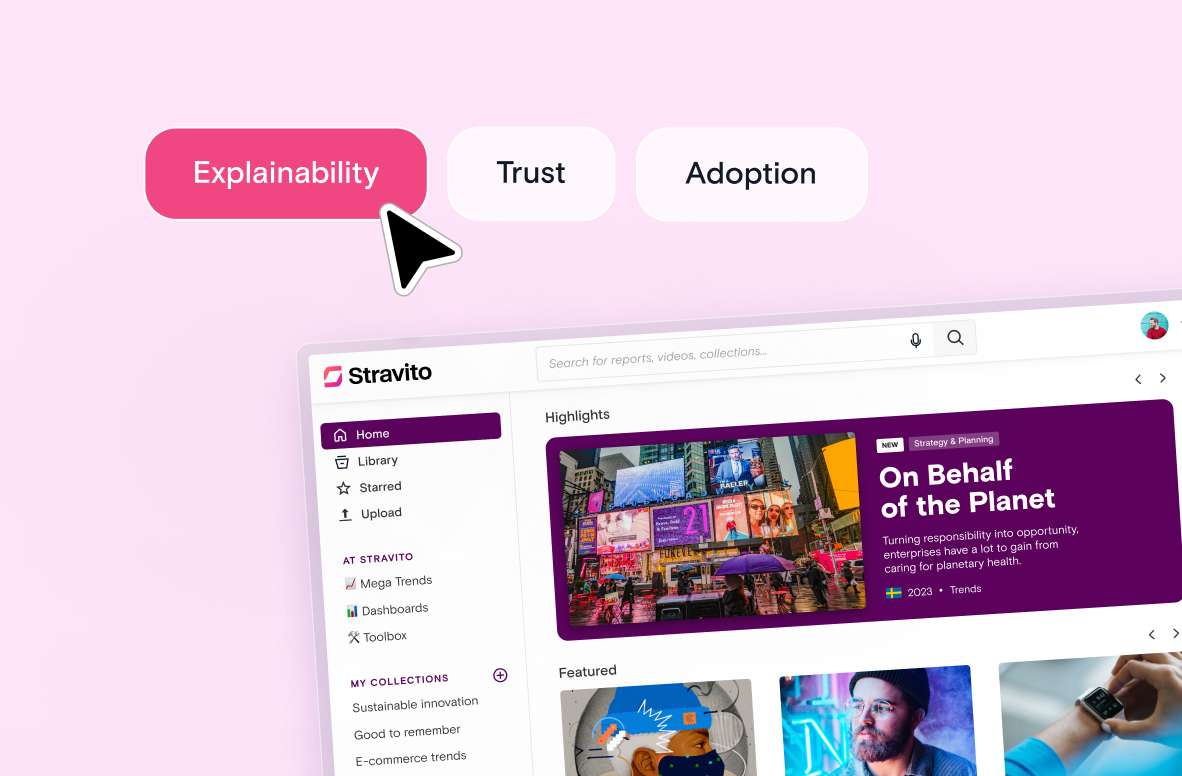Enterprise knowledge management often breaks down at the point of access. For global organizations, this leads to duplicated work, lost context, and delayed decisions.
Let's talk about where the breakdown happens...
Why enterprise knowledge sharing breaks down
The reality of silos in global organizations
In large enterprises, knowledge silos form quickly, especially across:
- Regions and business units
- Research tools and file systems
- Time zones and communication styles
When insights are scattered, teams struggle to see what already exists. That leads to inefficiencies, disconnected decision-making, and lost opportunities to build on collective knowledge.
Duplicated research, lost context, and disengaged stakeholders
Without a centralized knowledge repository that’s easy to use, teams often:
- Recommission research that already exists
- Miss key context like methodology, market, or timeline
- Abandon the system altogether when it doesn’t meet their needs
“Storage” ≠ usage: Why most KM platforms fail
Most enterprise knowledge management systems focus on storage. But without:
- Smart, semantic search
- Curated content delivery
- Easy-to-navigate UX
…your insights stay buried. A successful knowledge management strategy requires a platform built for activation, not just archiving.
If your enterprise knowledge management system isn’t driving usage, it’s time for a new approach.
Here are 13 practical tips we know will help global teams surface, share, and scale insights.
Tip 1: Build for discovery, not just storage
Why findability (not just completeness) is what scales
A complete knowledge repository isn’t enough. Teams need to find what’s relevant, fast. In global enterprises, that means discovery must work across formats, markets, and languages.
The best enterprise knowledge management systems focus on usability, not just completeness. If insights aren’t findable, they won’t be used.
How semantic search, auto-tagging, and curated collections drive impact
Discovery at scale depends on features that reduce friction for users and unlock the full value of knowledge assets, including:
- Semantic search that understands intent, not just keywords
- AI-powered auto-tagging to categorize insights with zero manual effort
- Curated collections that group insights by topic, region, or team
- GenAI assistants that summarize findings, suggest related content, and guide discovery
A solid knowledge management strategy starts with building a clear, centralized knowledge base that organizes insights for easy access across teams.
A knowledge management framework should always prioritize findability. Otherwise, insights stay hidden in plain sight.
With Stravito, global teams use semantic search and AI-powered discovery to surface insights instantly, across markets and formats.
Tip 2: Socialize insights, don’t just store them
Socialization = the missing link in most enterprise KM
Storing insights is easy. Getting people to actually engage with them? That’s the hard part.
In many enterprise knowledge management systems, insights are uploaded once and rarely seen again. But discovery isn’t just about search; it’s also about smart delivery.
To activate insights across global teams, they need to be shared in ways that are relevant, timely, and tailored.
Personalized feeds, stakeholder-driven collections, weekly digests
Insight socialization works best when it mirrors how people consume information in their day-to-day workflows. Look for features like:
- Personalized feeds that adapt to users’ roles, markets, and interests
- Stakeholder-driven collections curated by teams for specific business needs
- Weekly insight digests that push relevant updates directly to inboxes or platforms like Teams and Slack
- AI-generated summaries and teasers that encourage engagement with long-form research
Socializing insights helps knowledge stay visible, valuable, and ready to drive action.
A strong UX research data socialization strategy can be the difference between shelfware and shared understanding.
Tip 3: Reduce friction for uploaders and users
Why UX and zero-IT setup win
One of the biggest blockers to effective knowledge management is complexity. When uploading research is time-consuming or requires IT support, adoption stalls.
And if the user experience isn’t intuitive, knowledge stays untouched.
A good enterprise knowledge management system should work out of the box with no training, tickets, or workarounds.
Out-of-the-box onboarding, auto-tagging, no training required
Look for features that remove friction for both uploaders and users:
- Drag-and-drop uploads that require no technical know-how
- Auto-tagging and metadata extraction to eliminate manual effort
- Instant onboarding with no IT project required
- User-friendly UI that feels more like Netflix than SharePoint
Stravito is designed for fast adoption, even in large, decentralized teams. Uploads take seconds, search is effortless, and no technical training is needed.
A knowledge management platform only works if people actually use it. And all of that starts with great UX.
Tip 4: Activate insights at the point of decision
Integrate KM with daily workflows (Teams, Slack, dashboards)
Insights create impact only when they reach stakeholders in the flow of their work.
Embedding your enterprise knowledge management system into daily tools like Microsoft Teams, Slack, or business intelligence dashboards makes it easier for users to access relevant knowledge without switching contexts.
This seamless integration reduces friction and boosts timely, data-driven decisions.
The role of themed/role-based collections for different stakeholders
Different teams need different insights. Creating themed or role-based collections tailored to departments or decision-makers helps personalize knowledge delivery and improve relevance.
Whether it’s a product launch team, a regional marketing group, or executive leadership, curated collections ensure the right insights reach the right people at the right time.
Tip 5: Personalize, don’t overwhelm
Relevance over volume : personalized dashboards, targeted digests
In enterprise knowledge management, more isn’t always better. Delivering too many insights leads to overload, which hurts adoption and decision-making. Instead, focus on personalization. Dashboards and digests tailored to users’ roles, regions, and needs ensure relevant knowledge rises to the top.
Internal marketing for insights (auto-summaries, teasers, smart alerts)
To boost engagement, combine personalization with proactive communication:
- Auto-generated summaries that highlight key findings
- Insight teasers that spark curiosity
- Smart alerts for new or updated knowledge relevant to the user
This approach keeps stakeholders connected without overwhelming their inboxes or screens.
Tip 6: Track usage and prove impact
Usage stats, insight KPIs, time-to-decision, reuse rate
Measuring how knowledge is used helps demonstrate ROI and guides improvement.
Key metrics include:
- How often insights are accessed
- Time from insight availability to decision
- Rate of insight reuse across teams
Tracking these helps identify which content drives value and where gaps exist.
How analytics reveal “dark zones” and surface new needs
Analytics can highlight underutilized areas, or “dark zones,” where knowledge goes unused. This insight enables targeted training, content refreshes, or feature tweaks to boost engagement.
Stravito’s dashboards make it easy to monitor usage patterns and identify teams that need support, turning data into action.
Tip 7: Future-proof with GenAI and emerging tech
GenAI, semantic search, and their real role (not just buzz)
Generative AI isn’t a magic fix but a powerful tool for enterprise knowledge management when applied thoughtfully.
Features like AI-powered summaries, conversational search, and proactive content suggestions help teams sift through vast knowledge bases faster and uncover hidden insights.
Semantic search combined with GenAI improves discovery by understanding intent and context, making enterprise content knowledge management systems smarter and more user-friendly.
How emerging technologies enable smarter knowledge management
Beyond GenAI, emerging technologies such as machine learning and automation tools streamline knowledge capture, tagging, and maintenance. Now teams can reduce manual effort and increase data quality.
When we talk about these innovations, Stravito’s approach to AI knowledge management shows how future-ready systems support continuous learning and adapt as your organization’s knowledge needs evolve.
An enterprise knowledge management system built with future trends in mind supports continuous learning and adapts as your organization’s knowledge needs evolve.
Tip 8: Make knowledge transfer part of onboarding and exits
Structured onboarding/offboarding to protect institutional memory
Turnover is inevitable, but knowledge loss doesn’t have to be. Embedding knowledge transfer into onboarding and exit processes helps preserve valuable insights and tacit knowledge before employees leave or join.
Use case: Stravito collections as “onboarding packs” for new insight leads
Creating curated collections tailored for new hires ensures they quickly access relevant research, past learnings, and critical context. Stravito customers use these “onboarding packs” to accelerate ramp-up time and maintain continuity across teams.
Implementing these practices strengthens knowledge retention and reduces the risk of losing institutional knowledge during transitions.
Tip 9: Institutionalize lessons learned
Systematically capturing “What we’d do differently”
A formal process for capturing lessons learned after projects helps turn experience into valuable knowledge, strengthening your team’s organizational memory.
Documenting successes and mistakes creates a feedback loop that improves future research and decision-making.
Tag and surface learnings for future projects (reference smart collections)
Use smart tagging and collections to organize lessons learned, making them easy to find and apply. This ensures teams benefit from past insights rather than repeating avoidable errors.
Embedding lessons learned into your enterprise knowledge management system boosts continuous improvement and builds organizational wisdom over time.
Tip 10: Empower local teams to curate (not just consume) insights
Regional permissioning, decentralized curation, local relevance
Enterprise knowledge management works best when local teams can tailor insights to their markets. Setting regional permissions and enabling decentralized curation lets teams:
- Add and organize insights relevant to their specific region
- Highlight local trends, regulatory updates, and competitor activity
- Ensure knowledge reflects regional nuances and business needs
- Increase engagement by making content more relevant and actionable
Example: APAC insights manager uses Stravito to localize global research
For example, an APAC insights manager curates collections focused on regional consumer behavior and market dynamics. This local curation boosts relevance and helps teams across the enterprise make smarter, faster decisions.
Empowering local teams as curators builds a dynamic, living knowledge ecosystem that balances global strategy with local expertise.
Tip 11: Run regular “Insight Activation” workshops
Workshops that move from knowledge to business action
Insights only deliver value when they’re actively applied. Regular “Insight Activation” workshops help teams translate knowledge into concrete business decisions.
What these workshops should focus on:
- Reviewing key insights and their implications
- Identifying actionable next steps and owners
- Encouraging cross-team collaboration to break silos
- Addressing knowledge gaps and prioritizing new research
- Sharing success stories to build momentum and trust
Running these sessions regularly creates a culture where knowledge drives impact, not just storage.
Tip 12: Enable multilingual access and summarization
Breaking language barriers for truly global insight activation
In global enterprises, language differences can block knowledge sharing and slow decision-making. A knowledge management system that supports multilingual access ensures all teams can read and use insights in their preferred language.
Key features to look for:
- Automatic translation of reports and summaries
- AI-powered summarization to create quick, easy-to-digest versions
- Human review workflows to ensure accuracy and cultural sensitivity
- Search functionality that works across languages
These capabilities help global teams collaborate effectively, speeding up insight activation worldwide.
Tip 13: Protect knowledge during change (reorgs, M&A)
KM as insurance during company transitions
Organizational changes like reorganizations or mergers put institutional knowledge at risk. A robust enterprise knowledge management system acts as insurance, preserving critical insights despite staff turnover or shifting structures.
Best practices to safeguard knowledge:
- Document key learnings and decisions before transitions
- Use centralized repositories accessible across new teams
- Apply permissioning controls to protect sensitive information
- Plan for proactive knowledge transfer during onboarding and offboarding
By embedding knowledge protection into change processes, businesses reduce risk and maintain continuity.
How Stravito helps you succeed with enterprise knowledge management
Stravito is purpose-built to move beyond storing insights to making them truly usable across global teams. Its design focuses on real-world usage, so your teams find what they need quickly. And you don't have to wait for IT or wrestle with complex systems.
Key features that make Stravito stand out:
- Semantic search that understands intent, not just keywords
- Auto-tagging that saves time by organizing content automatically
- GenAI assistant providing instant summaries and relevant suggestions
- Out-of-the-box deployment with no heavy IT projects
- Role-based access controls to keep data secure and compliant
Customers use Stravito to break down knowledge silos, reduce duplicate research, and speed decision-making. This leads to a faster time to market and higher adoption of insights across global teams.
See how Stravito can unlock value for your team and request a Stravito demo.
From insight librarians to impact drivers: Unlock your team’s full potential
Turning insights into action is the real game-changer. When your research is accessible, discoverable, and socialized across teams, your business moves faster, smarter, and with confidence.
No more insight librarianship because Stravito helps your team become impact drivers who fuel decisions that matter. Accessible insights mean unstoppable growth.
Ready to close the gap between research and action? Book your Stravito demo today.
Enterprise knowledge management FAQs
1. What is enterprise knowledge management?
Enterprise knowledge management is the process of capturing, organizing, sharing, and applying knowledge assets across an organization.
It ensures that both tacit knowledge (personal know-how) and explicit knowledge (documented information) are accessible to knowledge workers, supporting better decision making and innovation.
2. How does a knowledge management system support enterprise knowledge?
A knowledge management system (KMS) provides a centralized knowledge repository where valuable knowledge is stored, managed, and shared.
This platform supports knowledge capture, knowledge retention, and knowledge sharing across departments, helping to break down knowledge silos and improve collaboration tools.
3. What types of enterprise-wide knowledge management systems are used?
Enterprise knowledge management systems vary but typically include content management systems, AI-powered knowledge bases, and automation tools.
These systems help with knowledge capture, organizing relevant knowledge, and providing easy access to up-to-date information for employees.
4. What is the role of knowledge management in decision-making?
Effective knowledge management ensures that decision makers have access to accurate, relevant information and organizational knowledge when they need it.
By using knowledge resources and collaboration tools, businesses can accelerate decision-making and maintain a competitive edge.
5. How do you manage tacit knowledge in an enterprise?
Managing tacit knowledge involves capturing personal expertise and experiences through collaborative tools, interviews, and documentation.
Enterprise knowledge management platforms facilitate this by enabling knowledge workers to share insights, identify knowledge gaps, and contribute to a collective knowledge base.
6. How does AI-powered knowledge management improve knowledge application?
Major challenges include overcoming knowledge silos, ensuring data quality, fostering a culture of knowledge sharing, and aligning technology infrastructure with business needs.
Proper planning and ongoing gathering of feedback from knowledge workers help address these challenges and support continuous improvement.
7. How does a centralized knowledge repository benefit organizations?
A centralized repository consolidates all enterprise knowledge into one accessible platform, improving easy access to knowledge, enhancing collaboration, and reducing duplicated research efforts.
It also supports knowledge maintenance and protects sensitive information.




